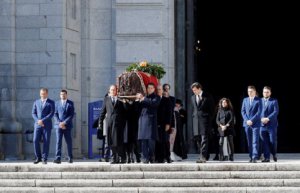This week the Spanish state finally took possession of a mansion previously ‘owned’ by Francisco Franco and used by his family after his death, following a court ruling that it had actually been illegally acquired by the dictator around 80 years ago. The state also took possession of a vast art and antiques collection, which Franco’s family also had to relinquish.
Built between 1893 and 1907, the Pazo de Meirás estate in the northwest Galicia region of Spain was acquired by a Francoist organisation during the Spanish Civil War (1936-1939) and later signed over to Franco, who was born in Galicia. It was then used by the dictator as an opulent summer residence. Following his death in 1975, his family claimed it as their private property, with it being used by six of the dictator’s grandchildren.
In 2018, Galicia’s regional government declared the 19th-century mansion to be of ‘historic and cultural value’, ordering the family to open it up to the public. But they fiercely opposed the move, still arguing it was private property.

In September this year, however, a court in the Galicia region ordered Franco’s family to turn it over to state ownership, upholding a Spanish government complaint that the sale of the property in 1941 was ‘fraudulent’. The Galician court had ruled that the donation in 1938 and subsequent sale in 1941 was ‘null and void’, since it was transferred to ‘the head of state and not to Francisco Franco personally’. It also found that the sale was little more than a ‘pretence’, given that ‘Franco did not pay anything’ for it.
After Franco’s heirs lost an appeal against the ruling, the Spanish government formally seized the palace from them on Thursday in a simple ceremony. In a statement, the court said a judge had ‘handed over the keys of Pazo de Meirás’ to the state in line with the ruling ‘in which it was agreed that the building was public property’.
The moment was another symbolic triumph for Spain’s left-leaning PSOE–Podemos coalition government’s efforts to erase the legacy of Franco’s dictatorship. Prime Minister Pedro Sánchez has made it a central campaign promise to ‘re-evaluate’ the dictator’s memory and how it is marked in official monuments. The government has repeatedly pushed to remove or reclaim other memorials that glorify the dictator’s nearly four-decade reign.

Handing over the mansion in Galicia is another setback for the Franco family. In 2019, after a bitter legal battle that reached Spain’s Supreme Court, the government also secured the exhumation of Franco’s remains from the grandiose Catholic mausoleum northwest of Madrid that had been built as his memorial. His remains were flown by helicopter to a discreet family plot in a cemetery near the Spanish capital, where he was reinterred next to his wife.
Spain’s deputy prime minister Carmen Calvo said in a statement that the transfer of ownership on Thursday was a credit to ‘the thousands and thousands of men and women from Galicia and the rest of Spain who have tried to make this place the birthright of all. This was a laudable objective, which dignifies Spanish democracy, which dignifies us all and which has been pushed by the activism of many people.’
Calvo also said that the government plans to re-use the mansion to educate the public about the dark side of Franco’s reign and celebrate the legacy of Emilia Pardo Bazán, a prolific writer whose family previously owned the property.
The transfer of ownership of Pazo de Meirás did not satisfy the Association for the Recovery of Historical Memory, however. The organisation, which dedicates itself to preserving the memory of Franco’s human rights abuses, tweeted that the return of the palace ‘cannot end without a judicial process against those who illegally occupied it and filled it with the fruit of a huge plunder of the state’s patrimony.’
La devolución del Pazo de Meirás no puede terminar sin un proceso judicial a quienes lo ocuparon ilegalmente y lo llenaron del fruto de un enorme expolio al patrimonio del Estado. https://t.co/BhDmRhP6Y5
— Memoria_ARMH (@ARMH_Memoria) December 9, 2020
ALSO READ (2/9/20): Court orders Franco’s family to return summer mansion
ALSO READ (25/10/19): Franco removed but ‘Francoism still very present’, argue many
ALSO READ (21/10/19): Franco’s remains to be exhumed on Thursday
ALSO READ (6/2/19): 656 municipalities ordered to remove Franco symbols
ALSO READ (1/11/18): Spanish artist defaces Franco tomb
ALSO READ (25/8/18): Franco’s family to ‘take care’ of remains
ALSO READ (16/7/18): Fascist protest against moving Franco’s remains
ALSO READ (16/2/19): Spotlight: ‘When you attack Franco, you attack over half of Spain’


